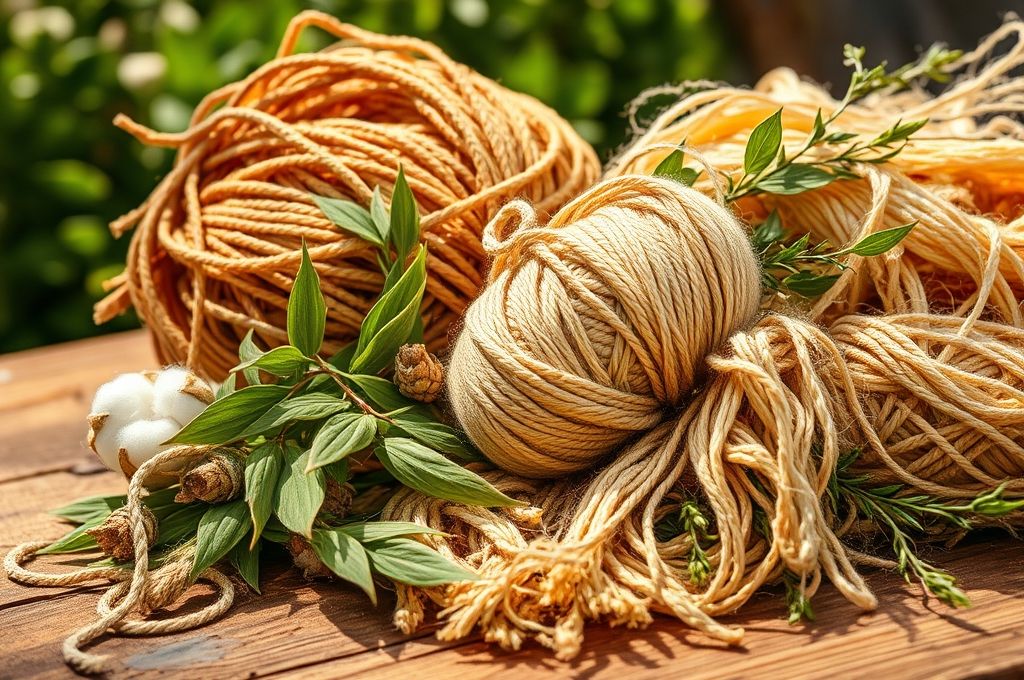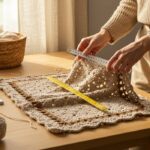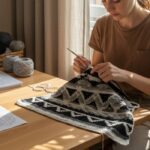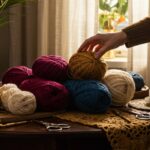Crafting with a Conscience
Imagine this: you’re curled up on the couch, hook in hand, creating a cozy blanket stitch by stitch. The yarn glides through your fingers—soft, colorful, and full of promise. But have you ever stopped to wonder where that yarn came from? What kind of impact its production had on the planet? If you’re like many crafters, you may not have considered it. Yet, every time we pick up a skein, we’re making a small but meaningful choice—one that can either support sustainable practices or contribute to environmental harm.
Crocheting is more than just a hobby. For many, it’s a form of self-expression, mindfulness, and even activism. And as awareness about climate change and ethical consumption grows, so does the desire to make eco-conscious choices—even in our crafting routines. That’s where eco-friendly yarn comes in.
In this article, we’ll explore the world of sustainable yarn options that let you create beautiful projects while honoring the planet. From natural fibers like organic cotton and bamboo to innovative recycled materials, we’ll break down what makes a yarn truly “green,” how to identify trustworthy eco-labels, and practical tips for building a more sustainable stash. Whether you’re a seasoned crocheter or just starting out, you’ll leave with fresh inspiration—and a few new yarns to try.
Let’s dive in.
Why Sustainable Yarn Matters: The Hidden Cost of Crafting
When we think about environmental impact, industries like fashion, transportation, or agriculture often come to mind. But the textile world—including yarn production—plays a surprisingly large role in global pollution.
Conventional yarns, especially synthetic ones like acrylic, are typically made from petroleum-based plastics. These materials don’t biodegrade and can shed microplastics every time they’re washed—tiny pollutants that end up in our oceans and even our drinking water. In fact, a single load of laundry can release hundreds of thousands of microfibers. Now imagine how many sweaters, scarves, and baby booties are made from acrylic every year.
Even natural fibers aren’t always as “green” as they seem. Conventional cotton, for example, is one of the most water-intensive crops in the world. It often relies on heavy pesticide use, which harms soil health, pollinators, and nearby communities. According to the World Wildlife Fund, it can take 2,700 liters of water to produce just one cotton t-shirt—enough to meet one person’s drinking needs for 2.5 years.
So what does this mean for crocheters? Simply put: our creative choices matter. By choosing eco-friendly yarns, we reduce demand for harmful production methods and support ethical, low-impact alternatives. It’s not about perfection—it’s about progress. And the good news? There are more sustainable options available today than ever before.
Natural & Renewable Fibers: Back to the Roots

One of the best ways to crochet sustainably is to go back to nature. Natural fibers are biodegradable, renewable, and often require fewer synthetic inputs during production. Let’s explore some of the top eco-friendly options:
Organic Cotton
Unlike conventional cotton, organic cotton is grown without synthetic pesticides or fertilizers. It uses less water thanks to better farming practices and often supports fair labor standards. Brands like We Are Knitters and Lion Brand’s Re-Spun line offer soft, certified organic cotton yarns perfect for baby clothes, dishcloths, and summer wear.
Hemp
Don’t let the name scare you—hemp is a powerhouse fiber. It grows quickly, enriches the soil, and requires little water or pesticides. Hemp yarn is strong, breathable, and gets softer with every wash. Though it can feel a bit stiff at first, it’s ideal for bags, market totes, and home decor.
Bamboo
Bamboo is one of the fastest-growing plants on Earth—some species grow up to 35 inches in a single day! It regenerates without replanting and absorbs more CO₂ than trees. Bamboo yarn is silky, lightweight, and naturally antibacterial, making it great for shawls, baby items, and sensitive skin.
Wool (Responsibly Sourced)
Wool is a renewable resource—sheep grow new fleece every year. But not all wool is created equal. Look for certifications like GOTS (Global Organic Textile Standard) or Responsible Wool Standard (RWS) to ensure humane treatment of animals and sustainable land management. Merino, alpaca, and Shetland wool are popular choices for warm, breathable garments.
TIP: When shopping, check labels for terms like “organic,” “undyed,” or “low-impact dyes.” These often signal a more sustainable product.
Recycled & Upcycled Yarns: Giving Waste a Second Life
If natural fibers are the foundation of sustainable yarn, recycled options are the innovation. These yarns take materials that would otherwise end up in landfills and transform them into something beautiful and useful.
Recycled Cotton
Made from post-industrial or post-consumer cotton waste (like leftover fabric from clothing factories), recycled cotton reduces water and energy use. It’s often blended with other fibers for strength. Patons’ Re-Tweed and Rowan’s Save the Sheep are excellent examples—cozy, textured, and planet-friendly.
Recycled Polyester (rPET)
Yes, polyester can be sustainable—when it’s recycled. rPET is made from plastic bottles collected from oceans and landfills. While it’s still a synthetic fiber, using recycled versions keeps plastic out of ecosystems and reduces reliance on virgin petroleum. Premier Yarns’ Anti-Pilling Everyday uses rPET and is perfect for durable, washable items.
Upcycled T-Shirt Yarn (Tarn)
This DIY favorite is made by cutting old cotton t-shirts into strips and joining them into a continuous yarn. It’s 100% recycled, colorful, and great for rugs, baskets, or chunky scarves. Plus, it’s a fun way to repurpose clothes you no longer wear.
Ocean Plastic Yarn
Some brands are going even further. Companies like Bureo and NetPlus (used by Patagonia) turn discarded fishing nets and ocean plastics into high-quality yarns. While not yet common in mainstream crochet lines, this technology is growing—and may soon become a staple in eco-crafting.
Why it works: Recycling yarn reduces waste, saves energy, and closes the loop in the textile lifecycle. It’s proof that sustainability doesn’t have to mean sacrifice.
How to Spot Truly Sustainable Yarn: Labels, Certifications & Red Flags

With so many brands claiming to be “eco-friendly,” how can you tell what’s real and what’s just greenwashing?
Look for These Certifications:
- GOTS (Global Organic Textile Standard): Ensures organic status from harvest to finished product, including ethical labor practices.
- Oeko-Tex Standard 100: Tests for harmful substances in textiles—great for baby yarns.
- Fair Trade Certified: Guarantees fair wages and safe working conditions.
- RWS (Responsible Wool Standard): Focuses on animal welfare and land management in wool production.
- GRS (Global Recycled Standard): Verifies recycled content and responsible manufacturing.
Ask These Questions:
- Where was the yarn made?
- What is it made from?
- How was it dyed?
- Is the packaging recyclable?
Red Flags to Watch For:
- Vague terms like “natural” or “eco-conscious” without proof.
- No information about sourcing or manufacturing.
- Overuse of synthetic blends without recycled content.
- Excessive plastic packaging.
Pro Tip: Support small, independent dyers and yarn companies that are transparent about their processes. Many hand-dyers use low-impact dyes and small-batch production, reducing environmental impact.
The Environmental Impact of Dyeing: Color with Care
Color brings joy to our projects—but traditional dyeing methods can be toxic. Conventional dyes often contain heavy metals, chlorine, and other chemicals that pollute waterways and harm workers.
Low-Impact Dyes
These are synthetic dyes that require less water, energy, and fixatives. They’re designed to bond efficiently with fibers, reducing runoff. While not “natural,” they’re a significant improvement over standard dyes.
Natural Dyes
Made from plants, roots, and minerals (like indigo, madder root, or onion skins), natural dyes are biodegradable and non-toxic. However, they require mordants (like alum) to set the color, and large-scale production can still use a lot of water. Best for small-batch or hand-dyed yarns.
Undyed Yarns
Sometimes, the most sustainable choice is no dye at all. Undyed, or “ecru,” yarns showcase the natural color of the fiber—creamy whites, soft browns, or warm greys. They eliminate dye pollution entirely and often feel more authentic and earthy.
DIY Natural Dyeing (Fun & Educational!)
Want to get creative? Try dyeing your own yarn with kitchen scraps:
- Avocado pits → soft pink
- Onion skins → golden yellow
- Black beans → soft blue-gray
It’s a rewarding way to personalize your stash and reduce reliance on commercial dyes.
Building a Sustainable Yarn Stash: Practical Tips for Crafters
Going green doesn’t mean starting from scratch. You can build a more sustainable stash gradually—without breaking the bank.
1. Audit Your Current Yarn
Take stock of what you already own. Can any of it be repurposed? Are there unfinished projects you can complete instead of buying new yarn?
2. Buy Less, Choose Well
Instead of impulse buys, invest in high-quality, eco-friendly yarns that will last. A single skein of organic merino might cost more, but it’s worth it if you love how it feels and know it was made ethically.
3. Shop Local & Small-Batch
Support local yarn stores (LYS) and indie dyers. They often carry unique, sustainable options and reduce shipping emissions compared to overseas retailers.
4. Join Yarn Swaps or Trade Groups
Many online communities (like Ravelry or Facebook groups) host yarn swaps. Trade yarns you don’t need for ones you’ll love—zero waste, maximum fun.
5. Repurpose & Upcycle
Turn old sweaters into yarn by unraveling and re-winding (called “deconstructing”). It’s a great way to get free, unique yarn—plus, it’s already been made, so no new resources are used.
6. Store Yarn Responsibly
Keep your yarn in breathable cotton bags or recycled containers. Avoid plastic bins that trap moisture and promote mildew.
7. Think Long-Term
Choose timeless colors and fibers that won’t go out of style. A neutral organic cotton can be used for years across many projects.
Eco-Friendly Crocheting Beyond Yarn: Tools, Habits & Mindset
Sustainability isn’t just about materials—it’s also about how we craft.
Sustainable Hooks & Tools
Swap plastic hooks for ones made from:
- Bamboo
- Wood
- Recycled aluminum
- Corn-based bioplastics
Brands like Clover and Knitter’s Pride offer eco-conscious options that are lightweight and durable.
Energy & Water Use
Washing finished items in cold water and air-drying them saves energy. Hand-washing with eco-friendly detergent (like Woolite Green or Ecover) reduces chemical runoff.
Mindful Making
Slow down. Crocheting is a form of mindfulness. When we make things by hand, we value them more. This mindset leads to fewer fast-fashion-style projects and more cherished heirlooms.
Teach & Share
Pass on your skills. Host a workshop, teach a friend, or donate handmade items to shelters. Sustainable crafting is also about community and connection.
Celebrate Imperfection
Handmade items aren’t meant to be perfect. A slightly uneven stitch or a color variation tells a story. Embrace it. That’s what makes your work unique—and human.
Top 5 Eco-Friendly Yarn Brands to Try Today
Ready to make the switch? Here are five standout brands offering sustainable, crocheter-approved yarns:
1. We Are Knitters (Spain)
Known for their stylish kits, they use 100% organic cotton, merino wool, and alpaca. Packaging is recyclable, and they’re transparent about sourcing.
2. Manos del Uruguay (Uruguay)
A fair-trade cooperative empowering women artisans. Their hand-dyed merino and silk blends are stunning, and every skein supports a community.
3. Juniper Moon Farm (USA)
Offers a range of natural fiber yarns, including organic cotton and yak blends. They prioritize animal welfare and eco-friendly practices.
4. Sandnes Garn (Norway)
Popular for their durable, rustic yarns like Bomull Lin (cotton-linen blend). Many are undyed or use natural dyes.
5. The Woolly West (USA)
Specializes in regeneratively sourced wool from small ranches in the American West. Their mission? To heal the land, one sheep at a time.
Each of these brands proves that sustainability and beauty can go hand in hand—literally.
The Ripple Effect: How Your Crochet Can Change the World
It’s easy to think, “I’m just one person. Does my yarn choice really matter?” But here’s the truth: every stitch is a vote.
When you choose organic cotton over acrylic, you’re supporting farmers who care for the soil. When you buy from a fair-trade cooperative, you’re helping someone earn a living wage. When you reuse yarn or host a swap, you’re reducing waste and inspiring others to do the same.
And the ripple doesn’t stop there. Your handmade scarf might become a gift that sparks a conversation. Your zero-waste basket might inspire a friend to start upcycling. Your commitment to sustainable crafting can influence trends, shift demand, and even push big brands to do better.
Remember: movements start with individuals. And crafters? We’re a powerful force. We create, we care, and we connect. By choosing eco-friendly yarn, we’re not just making blankets—we’re weaving a better future.
Conclusion: Stitch by Stitch, We Grow Greener
Crocheting is more than a pastime—it’s a form of expression, healing, and quiet rebellion against mass production. And when we choose sustainable yarn, we add another layer: responsibility.
From natural fibers like organic cotton and hemp to innovative recycled materials, the options for eco-friendly yarn are richer and more accessible than ever. Certifications help us make informed choices, while mindful habits—like reusing, swapping, and slow crafting—deepen our connection to our creations and the planet.
You don’t need to overhaul your entire stash overnight. Start small. Pick one eco-friendly yarn for your next project. Try natural dyeing. Support a local artisan. Every choice counts.
So the next time you pick up your hook, take a moment to appreciate not just the beauty of your work, but the story behind it. Who made the yarn? Where did it come from? What impact did it have?
Because in the end, the most sustainable project isn’t just the one that lasts a lifetime—it’s the one made with love, intention, and respect for the Earth.
Now, I’d love to hear from you: What’s your favorite eco-friendly yarn, or what step will you take today to make your crocheting more sustainable? Share your thoughts in the comments—let’s grow this green crafting community together.
Happy hooking—sustainably! 🌿🧶

Daniele Ferreira is passionate about the world of crochet, dedicating her time to exploring techniques, creating unique pieces, and sharing her knowledge with beginners and aficionados alike. With attention to detail and creativity, she transforms yarn into true works of art, inspiring others to discover the beauty and joy of this manual art.







